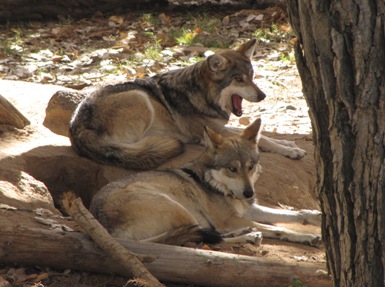New in the Press: Carlsbad Mexican gray wolf to mate with Mexican female in breeding program
By Stella Davis
Current-Argus Staff Writer

The wolf, sent to Centro Encologico de Sonora in Hermosillo, Sonora, Mexico, is one of six Mexican gray wolf brothers housed at the park that came from the Wild Canid Research and Survival Center in Eureka, Mo.
The endangered wolves are placed in institutions by the Association of Zoos and Aquariums through the Mexican Wolf Species Survival Plan, said Holly Payne, park general curator.”¦
“The AZA Species Survival Plan contacted us and said the facility in Mexico has a single female that is genetically important and since our six brothers also are important genetic-wise, they recommended breeding one of our males with the female in Mexico,” Payne explained. “But before we could do that, we had to go through a lot of red tape and complete a lot of paperwork. For us, this is the first time we have sent one of our animals to another country. The transfer of the wolf was a huge collaborative effort with a lot of people and agencies involved.”
In addition to the park, agencies involved in the transfer include LightHawk – a nonprofit organization that aids animal conservation efforts by donating flights and pilots – Association of Zoos and Aquariums Mexican Wolf Species Survival Plan, U.S. Fish and Wildlife Service, USDA and the Mexican government. “¦
According to the AZA Mexican Wolf Species Survival Plan, the Mexican gray wolf or “lobo” is the rarest, southernmost and most genetically distinct sub-species of gray wolf found in North America. Adult wolves typically weigh 50-80 pounds, are about 5 feet in total length and have a richly colored coat of buff, brown, gray, red, white and black.
The Mexican gray wolf breeding program began in the late 1970s with the capture of five wolves from the wild. Later, in the mid 1990s, a few additional wolves were confirmed to have been pure Mexican wolves as well. With careful breeding and husbandry management, the population increased.
The government predator control programs from the 1890s through the 1960s targeted the wolf for extermination to protect ranchers from livestock losses. Professional trappers and chemical poisons have eliminated the Mexican gray wolf from its former range in the southwest U.S. and Mexico. “¦
To read the full article, published in the Carlsbad Current-Argus on December 27, 2010, and post a comment, click here.
Please submit a letter to the editor expressing support for the wolf reintroduction and calling on Congress to maintain the highest possible protections for endangered Mexican gray wolves: marthamauritson@currentargus.com
Photo credit: Mexican gray wolves in captivity, courtesy of Jean Ossorio



